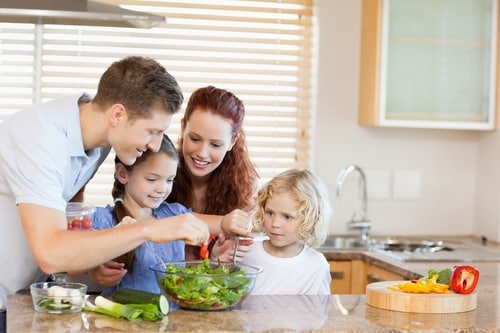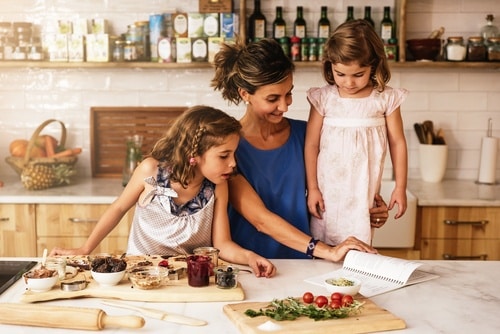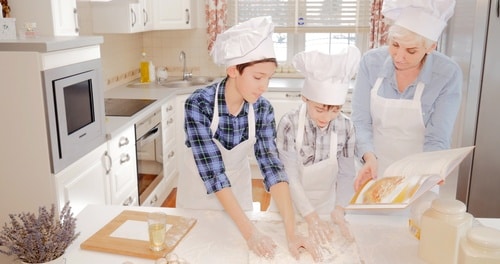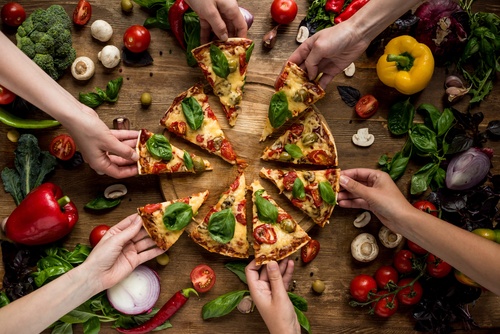Obesity, diabetes, and other diet-related conditions are becoming a major issue around the world, especially around the Western World. We’re eating more processed foods and sugary items than ever before. …..
Obesity, diabetes, and other diet-related conditions are becoming a major issue around the world, especially around the Western World. We’re eating more processed foods and sugary items than ever before. It’s understandable why we do it. Processed food is quicker and easier for many people. After an 8-hour day at the office, we’re not interested in cooking for a house full of people, right?
The problem is our food choices are making us extremely unhealthy. They’re also setting up bad examples for our children.
Your kids watch what you eat. If they see you eating processed food and making unhealthy choices daily, they will follow suit. It’s important to help them make healthier choices from an early age. If left to their own devices, they would happily choose the awesomely marketed chocolate bars and the delicious, sugar-filled cookies.
How do you help children make healthy food choices? Here are steps that you can take right now.
Lead by Example

Honestly, the best way to help children make healthy food choices from an early age is to set a good example. Make the healthy food choices yourself while in front of them.
Let them see you choose an apple or a banana as a snack instead of the cookies from the jar. Let them watch you pick a handful of nuts instead of choosing the chocolate or crisps.
But don’t just let them see you make the fast food choices. Let them understand your mindset and tell them why you choose the healthier food choices. Show them the pros and cons and make a big deal about your options. Kids are more receptive when they understand why you’re doing something.This also helps their decision-making skills in the future.
Talk about how much healthier the right food is. What does it do for your long-term energy levels? How will it help your brain and heart? What’s it going to do for your digestive system and your immune system? Then look at the unhealthier choices and show how they aren’t the same. Talk about how the sugar is a short-term energy boost that puts the rest of your health at risk.
You don’t need to get too complicated with this stage, depending on the age of your children. You just need to make a point about how good for you the healthier choices are and why you will pick them over the unhealthy options. As your children get older, you can go into more depth if you’d like. At a young age, too much explanation is going to go over their heads.
Keep the Options Limited
When children are younger, you want to help their decision making without overwhelming them. Food is a good way to help their decision-making skills, and you can also encourage choosing good food more often than the unhealthy options.
The best way to help them is through limiting the options. You don’t need to let them choose everything in the cupboard. Just give them two or three choices at the very most. Any more than this and children will become overwhelmed and end up not making any choice.
Think what it’s like in the grocery store. You can sometimes struggle with the food choices because there are so many options. You want to get the best deal for your money while choosing something that is appetizing and will make you feel good and happy. As adults, we learn to deal with more choices, but children haven’t developed that ability yet.
Overwhelmed children will just go for the easiest of options: usually, the one that they are most familiar with. If this means the unhealthy choice, then they don’t think about the consequences. They just want to plan and get out of the situation.
The decisions they make from your limited options don’t always have to be the right ones. Sometimes they will want the unhealthy food, and they need to know that you will respect their decisions and choices. Let them have the poor food choices now and then. When you want to make sure they make a good choice, limit your options to only good ones so they can’t “lose.”
Making poor decisions is part of the learning process. They will learn how they feel during and after eating something. They can find out how their energy levels are affected by both good and bad choices. As they get older, they will start to remember the way they felt, and that will help them make better choices in the future.
Read Food Choice Books with Them

There are now many books written about making food choices. Children’s authors understand that this is a problematic part of being a parent, so they’ve created fictional stories that will help children. After all, if children see their favorite characters make healthy food choices, then they are more likely to make the good choices too. They want to be like their favorite characters.
You can do story time from a very young age. Babies may not understand the words, but they love looking at the pictures and will enjoy hearing your voice. This is also a good bonding moment with your babies. As babies get older, they will want to have story time more often with you and can get to the point where they read the story instead. Encourage them reading the story aloud.
Don’t forget to talk about the story afterward. Talk about how the character made a good food choice and selected something that your children don’t usually pick. By making this point, your kids will see that they can be “cool” and eat good food at the same time.
You can do something similar with the TV. While experts don’t recommend a lot of TVs, between the ages of 2 and 12, 30-45 minutes of TV isn’t going to be that bad for them. They can learn a lot from watching their favorite characters make good food choices and even healthy choices in their lives.
Some computer games are also using food within them. Consider pulling them out. This will help you interact with your children in a medium that they prefer.
Get Them Involved in the Cooking

Let children see how the right food is used for the kitchen. Let them take part in the peeling, grating, mixing, and more. As they get older, they can even get involved in the cutting and baking process of making meals.
When children get involved in the cooking, they are more likely to eat it. They see just how much work goes into making the food, which helps them gain some appreciation for the healthy choices. They feel more at ease to make healthy food choices later since they’re more at ease with using them in their meals.
This doesn’t just help children make healthy food choices from an early age. Getting them involved in the cooking will also help you get rid of some picky eating tendencies.
Another method that helps with getting kids involved is by having a family garden. Let children see where the good food comes from and how they can help make it grow. Let them help water the plants and even pick the fruits or vegetables from the ground. If you have space and the time, you could even get livestock to let them see where milk and eggs come from.
By them seeing more of the process of getting food, they are more likely to choose it. They want to eat the product of their hard work.
Live in an apartment? You can still grow some food. Herbs are excellent for apartment growing. Create a small windowsill or balcony herb garden. You’ll be able to smell the good food growing throughout the day, and your kids will be eager to find a way to use them in their meals.
Encourage Children to Help with the Meal Planning
You want to plan your meals to help always choose something good to eat. This can also help your bulk cook, so you have quick meals some nights of the week. Don’t just make the choices between the adults. Get the kids involved with the meal planning.
This is part of the decision making the process that kids will need to go through. Let them look through cookbooks and magazines for some ideas. You could even take photos of your meals and show them when discussing the menu. This will help them remember what a meal is and help them choose it later.
Children who get to help with the meal plan will understand more about what goes into cooking. They learn more about creating meals from fresh foods, instead of constantly ordering takeaways or opting for processed meals. Making these choices with you will give them a voice, and they are more likely to gain decision-making skills for the future.
They will find it easier to create meal plans in the future. It becomes part of normal family life. You can even set up a set schedule for meal planning and preparation. This will help them create a routine early that they are more likely to stick to in the future.
Teach Them About Food and the Differences

Children don’t understand the difference between a banana and a chocolate bar at first. To children, the two options will offer the same calories, the same energy levels, and the same nutrients. The chocolate bar is just better packaged, and they think it will taste better.
It’s when we get older that we learn more about food and nutrients. So, you can’t expect children to choose a banana off the bat without encouragement.
The best support that you can give is helping children understand the differences between types of food. Don’t just label food good and bad. You need to help them figure out why some choices are better than others. Help children understand more about whole grains, how fiber will fill them up, and what nutrients will do to their bodies. Teach them more about how sugars affect the body and what sodium will do.
Some of this will come with age. You’ll need to start off small and work your way up.
The good news is there are apps out there that will help. Download a few kids’ food apps onto your phone or tablet and spend some time with your children to understand more about their choices.
You can also turn the food choices into something fun. Make the decision making the process a game and turn boring-looking food into something appealing. You’ll be surprised how much children forget about chocolate when they get to eat “fox sandwiches.”
Not all the facts have to be about the healthy elements within the food. Find out some fun facts about healthy food, such as how apples can float in water. Play games like bobbing for apples and races with raisins on the table. The more fun children have with good food, the more good choices they will make.
Don’t Completely Ban Bad Food

Children who don’t get to eat any chocolate, crisps, and cookies can end up going off the rails later in life. They have food that is completely banned, and they just want to know why. They can’t understand why others get to eat them and they’re not allowed. In the end, they eat the food when you’re not allowed and will binge because they don’t know when they can get it next.
As they get older and live alone, they will choose the food that they were never allowed. After all, they’re making up for years of the food being banned.
The worst thing you can do is entirely ban food from your home. What you want to do is make the food occasional options. Teach children all about everything in moderation. You encourage good choices most of the time, but make it clear that bad choices are okay now and then.
Source: How To Teach Your Children To Make Good Food Choices At An Early Age












